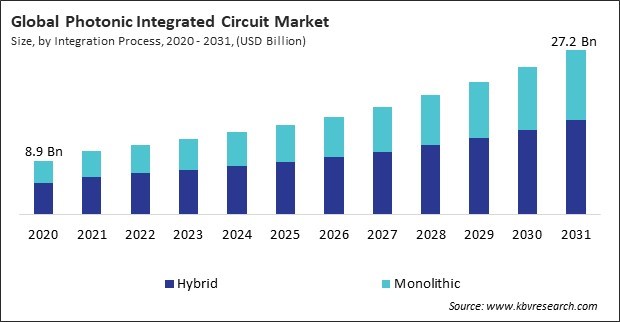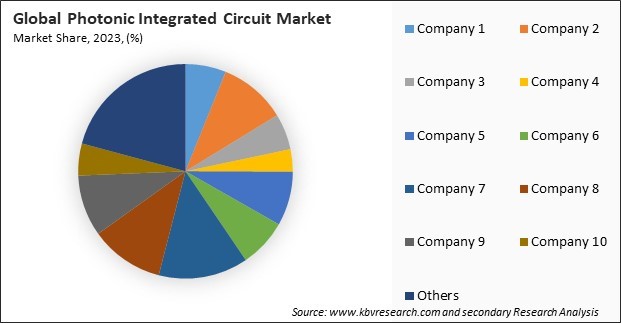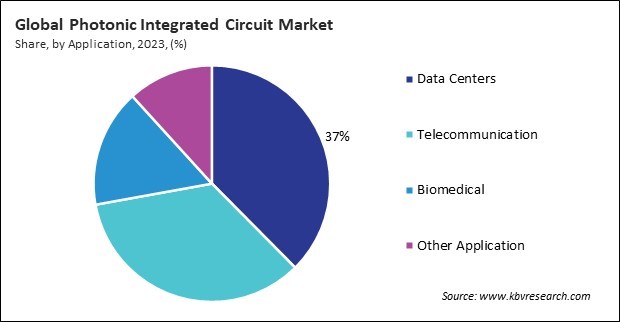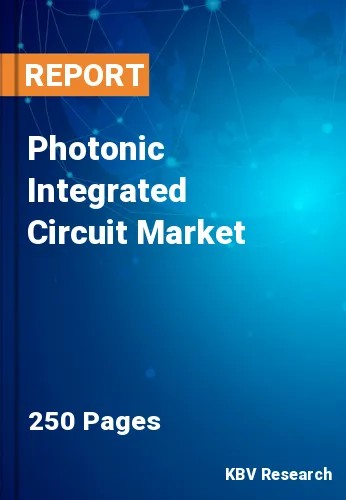“Global Photonic Integrated Circuit Market to reach a market value of 27.2 Billion by 2031 growing at a CAGR of 10.4%”
The Global Photonic Integrated Circuit Market size is expected to reach $27.2 billion by 2031, rising at a market growth of 10.4% CAGR during the forecast period.
The North America segment procured 37% revenue share in the photonic integrated circuit market in 2023. This leadership can be attributed to major technology companies, robust research and development activities, and significant investments in telecommunications and data centers. The region is also home to several key players in the photonics industry, driving innovation and advancements in photonic technologies.

As the digital economy expands, fueled by the exponential growth of internet usage, cloud computing, and the proliferation of data centers, the need for faster, more reliable data transmission has become paramount. The global data sphere is anticipated to increase from 33 zettabytes in 2018 to 175 zettabytes by 2025, as per a blog post from the International Data Corporation (IDC). With more than 5.4 billion active internet users worldwide, the demand for digital content is ever-increasing, leading to a surge in the creation of multimedia assets across various sectors, including retail, entertainment, and education. Hence, these factors will aid in the expansion of the market.
Additionally, The global rollout of 5G networks is transforming telecommunications by enabling faster speeds, lower latency, and greater capacity, essential for emerging technologies like autonomous vehicles, smart cities, and IoT. According to the International Telecommunication Union (ITU), since commercial deployment began in 2019, 5G coverage has increased to 40 percent of the world population in 2023. ITU stated that a 5G network covers 89 percent of the population in high-income countries; coverage remains limited in low-income countries. Thus, as 5G networks continue to expand and new applications emerge, the role of PICs in building and maintaining the infrastructure for next-generation telecommunications will only grow in importance.
However, Designing PICs requires advanced technology integrating optical components like lasers, modulators, and detectors onto a single chip. This integration is far more complex than traditional electronic circuits, necessitating sophisticated design tools, precise alignment, and advanced simulation software. Additionally, the materials used in PIC fabrication, such as indium phosphide or silicon photonics, are more expensive than those in standard electronic circuits, driving up material costs. Hence, the market expansion of PIC technology is constrained.

The leading players in the market are competing with diverse innovative offerings to remain competitive in the market. The above illustration shows the percentage of revenue shared by some of the leading companies in the market. The leading players of the market are adopting various strategies in order to cater demand coming from the different industries. The key developmental strategies in the market are Acquisitions, and Partnerships & Collaborations.
On the basis of integration process, this market is bifurcated into hybrid and monolithic. The monolithic segment recorded 40% revenue share in this market in 2023. Monolithic PICs are fabricated using a single material platform, which simplifies manufacturing processes and can reduce production costs. This approach is particularly beneficial for producing large volumes of passive optical components and devices, ensuring reliability and consistency.
By application, this market is divided into telecommunication, biomedical, data centers, and others. The telecommunication segment garnered 36% revenue share in this market in 2023. This segment's growth is driven by the ongoing expansion of broadband networks and the increasing deployment of 5G technology, which requires high-capacity and reliable communication solutions.

Based on material, this market is classified into III-V material, lithium niobate, silica-on-silicon, and others. The lithium niobate segment procured 31% revenue share in this market in 2023. Lithium niobate is known for its electro-optic and nonlinear optical properties, making it an excellent choice for applications like modulators, switches, and waveguide devices. The adoption of lithium niobate-based PICs has been precipitated by the growing demand for high-performance optical devices in photonic computing and telecommunications.
Free Valuable Insights: Global Photonic Integrated Circuit Market size to reach USD 27.2 Billion by 2031
Region-wise, this market is analyzed across North America, Europe, Asia Pacific, and LAMEA. The Asia Pacific segment acquired 27% revenue share in this market in 2023. China, Japan, and South Korea are at the forefront of the development and deployment of these circuits, predominantly due to the expansion of their telecommunications and consumer electronics sectors.
| Report Attribute | Details |
|---|---|
| Market size value in 2023 | USD 12.5 Billion |
| Market size forecast in 2031 | USD 27.2 Billion |
| Base Year | 2023 |
| Historical Period | 2020 to 2022 |
| Forecast Period | 2024 to 2031 |
| Revenue Growth Rate | CAGR of 10.4% from 2024 to 2031 |
| Number of Pages | 250 |
| Tables | 360 |
| Report coverage | Market Trends, Revenue Estimation and Forecast, Segmentation Analysis, Regional and Country Breakdown, Market Share Analysis, Porter’s 5 Forces Analysis, Company Profiling, Companies Strategic Developments, SWOT Analysis, Winning Imperatives |
| Segments covered | Integration Process, Application, Material, Region |
| Country scope |
|
| Companies Included | Agilent Technologies, Inc., Broadcom, Inc., TE Connectivity Ltd., Hewlett Packard Enterprise Company, Nokia Corporation, Coherent Corp., Intel Corporation, Cisco Systems, Inc., Huawei Technologies Co., Ltd. (Huawei Investment & Holding Co., Ltd.), and Juniper Networks, Inc. |
By Integration Process
By Application
By Material
By Geography
This Market size is expected to reach $27.2 billion by 2031.
Rising Demand For High-Speed Data Transmission are driving the Market in coming years, however, High Initial Costs And Complex Manufacturing restraints the growth of the Market.
Agilent Technologies, Inc., Broadcom, Inc., TE Connectivity Ltd., Hewlett Packard Enterprise Company, Nokia Corporation, Coherent Corp., Intel Corporation, Cisco Systems, Inc., Huawei Technologies Co., Ltd. (Huawei Investment & Holding Co., Ltd.), and Juniper Networks, Inc.
The expected CAGR of this Market is 10.4% from 2024 to 2031.
The Data Centers segment led the maximum revenue in the Market by Application in 2023, thereby, achieving a market value of $9.7 billion by 2031.
The North America region dominated the Market by Region in 2023, and would continue to be a dominant market till 2031; thereby, achieving a market value of $9.8 billion by 2031.
Our team of dedicated experts can provide you with attractive expansion opportunities for your business.

 Drivers
Drivers
 Restraints
Restraints
 Opportunities
Opportunities
 Challenges
Challenges
